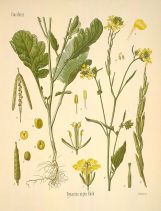Keen as Mustard
By Audrey Stallsmith

GRUMIO: What say you to a piece of beef and mustard?
KATHARINA: A dish that I do love to feed upon.
GRUMIO: Ay, but the mustard is too hot a little.
KATHARINA: Why then, the beef, and let the mustard rest.
GRUMIO: Nay then, I will not: you shall have the mustard, Or else you get no beef of Grumio.
William Shakespeare, The Taming of the Shrew
Our Pennsylvania fields bloom sunny with dandelions and mustard in May. Though we farm people deplore those weeds most of the year, we have to admit that they look cheery in the spring!
I am not sure, however, whether our "mustard" is one of the genuine mustards such as Brassica nigra or alba, a wild mustard such as Brassica Kaber (AKA charlock or sinapsis arvensis), or perhaps not a mustard at all. I've heard that wintercress, Barbarea vulgaris, has a similar look.
But this article will focus on the real thing, which has been around for as long as civilization. As the word brassica implies, the mustards are part of the cabbage family. They are mentioned in the Code of Hammurabi (around 2,000 BC) and traveled with the Romans. (The "mustard seed" reference in the New Testament, however, was obviously to a tree--perhaps Salvadora persica or khardal.)
The condiment's name derives from the fact that the Romans liked to steep their crushed brassica seeds in must--the juice of unfermented grapes. So "mustard" is a combination of the Latin mustum ("must") and ardens ("burning").
Those soldiers also mixed the crushed seeds with crayfish powder to treat their wounds. A canny idea as, due to its sulphur compounds, mustard does have antiseptic and antibiotic properties. I can't help thinking, however, that the ancient version of Neosporin probably burned a bit!
That irritation is, though, apparently part of the reason that mustard plasters were once considered a must for the treatment of aches and pains. As James Duke explains in The Green Pharmacy, "mustard is a rubefacient counterirritant, which means it causes a soothing feeling of warmth in the skin whiles its counterirritant properties cause mild irritation, distracting the body from the deeper pain. . ."
Those plasters also relieved chest congestion. A mother who wasn't a sadist, however, always placed a layer of muslin between the mustard and her child's chest. She also left the plaster on only until the skin began to redden--not until it blistered! Balding men sometimes applied these plasters to their heads to stimulate hair growth, and mustard tea purportedly cures hiccoughs.
In Europe, mustard was originally sold as balls of seeds held together by a mixture of vinegar and honey. When needed, the mustard was "relented," crushed and mixed with more vinegar. Because mustard doesn't release its flavor or heat until it is pulverized, those whole seeds stood for "indifference" in the Language of Flowers.
Our common American or "ballpark" mustard is usually made from white mustard seeds (Brassica alba), vinegar, and turmeric. The more classy types like Dijon, however, usually employ black (Brassica nigra) or brown (Brassica juncea) mustard seeds and verjus (juice of unripe grapes), wine, or wine vinegar.
"The seede of Mustard," John Gerard enthused in the sixteenth century, "pounded with vinegar is an excellent sauce, good to be eaten with any grosse meats, either fish or flesh, because it doth help digestion, warmeth the stomach, and provoketh appetite." In those pre-refrigeration days, some of the meat probably was literally gross, so mustard's sharp flavor would help cover that up--and perhaps might even kill a few bacteria!
Too much mustard, of course, can cause indigestion rather than relieve it. And it may provoke another type of appetite as well, since the Chinese considered the condiment an aphrodisiac. Residents of Denmark and India, on the other hand, believed it to be a repeller of sorts--as they scattered mustard seeds around their homes to keep out evil spirits.
German brides sewed those seeds into the hems of their gowns to assure their dominance in the household. Mustard is indeed a dominant spice, the second most popular in this country after pepper.
Young mustard leaves can be eaten early in the spring, either as a salad green or cooked vegetable. The flower heads are also edible and said to have a "more mellow" taste than the "biting" greens.
Mustard is most loved for its bite, however. Although Bottom says to Master Mustardseed in A Midsummer Night's Dream, "I promise you your kindred had made my eyes water ere now," he quickly adds, "I desire your more acquaintance, good Master Mustardseed."
Brassica nigra image is from Kohler's Medizinal-Pflanzen, courtesy of the Missouri Botanical Garden.








